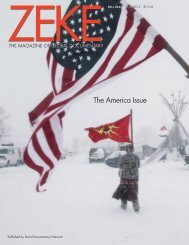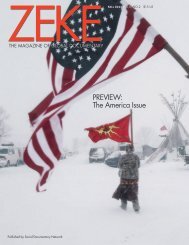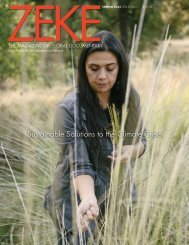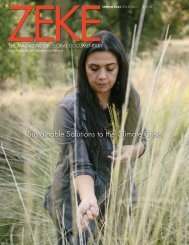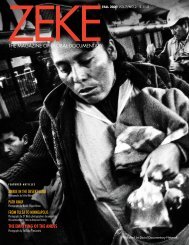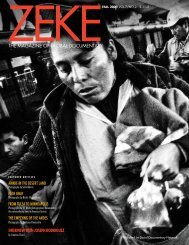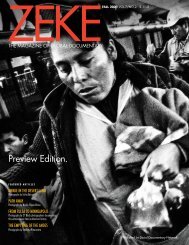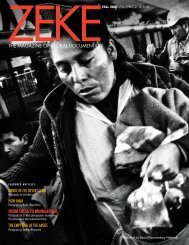ZEKE Fall 2019
Contents includes: "Youth of Belfast" by Toby Binder, and "Delta Hill Riders" by Rory Doyle, winners of ZEKE Award for Documentary Photography "Rising Tides" with photographs by Sean Gallagher, Lauren Owens Lambert, and Michael O. Snyder "Out of the Shadows: Shamed Teen Mothers of Rwanda" by Carol Allen Storey Interview with Lekgetho Makola, Head of Market Photo Workshop, South Africa, by Caterina Clerici "Why Good Pictures of Bad Things Matter" by Glenn Ruga Book Reviews and more...
Contents includes:
"Youth of Belfast" by Toby Binder, and "Delta Hill Riders" by Rory Doyle, winners of ZEKE Award for Documentary Photography
"Rising Tides" with photographs by Sean Gallagher, Lauren Owens Lambert, and Michael O. Snyder
"Out of the Shadows: Shamed Teen Mothers of Rwanda" by Carol Allen Storey
Interview with Lekgetho Makola, Head of Market Photo Workshop, South Africa, by Caterina Clerici
"Why Good Pictures of Bad Things Matter" by Glenn Ruga
Book Reviews and more...
- No tags were found...
You also want an ePaper? Increase the reach of your titles
YUMPU automatically turns print PDFs into web optimized ePapers that Google loves.
CC: Are similar dynamics happening<br />
across the African continent?<br />
Lekgetho Makola viewing the Photo Incubator exhibition at the Photo Workshop Gallery.<br />
Photo by Siphosihle Mkhwanazi.<br />
beginning to author their work and stage<br />
their images to tell a very particular story.<br />
We still have a traditional documentary<br />
photography practice, but overall we’re<br />
seeing images going more toward fine arts.<br />
People are redefining what an image is —<br />
for example, introducing moving images,<br />
because smartphone cameras or DSLRs<br />
all have video functions. We see a lot of<br />
experimentation, a beautiful mix of ideas,<br />
still within the critical narrative space.<br />
CC: The photo industry seems to be finally<br />
diversifying. The more voices are let in, the<br />
more the practice is questioned, and, with<br />
it, who has the right to tell a story. Given<br />
its roots, can there be photojournalism<br />
without a Western filter?<br />
LM: The practice of photography in the<br />
continent is growing and people are<br />
beginning to document themselves in their<br />
own communities. A person who goes into<br />
their township and knows the dynamics<br />
of their home is able to photograph it in a<br />
particular way, unlike for instance AFP or<br />
Reuters photographers who parachute into<br />
a village, photograph the story and leave.<br />
We are hoping to host the <strong>2019</strong> World<br />
Press Photo Awards here at the MPW, and<br />
I was telling the people in Amsterdam that<br />
it’s important for them to know there is this<br />
reluctance to accept the World Press Photo<br />
as the space that every year decides what<br />
a good photograph is. It becomes difficult<br />
for these juries to questions themselves<br />
and their idea of photography, since<br />
they already believe they are the leading<br />
authorities in deciding what a good image<br />
actually is.<br />
There are many photographers from<br />
outside Africa coming to the Continent<br />
and photographing it, and their work gets<br />
accepted to many festivals and biennales<br />
in Europe, but it’s hard to find somebody<br />
from the Continent, who photographs the<br />
same issues, accepted in those spaces.<br />
This is problematic. The question is:<br />
what stories are being told, and for what<br />
purpose? I think we are still living in a<br />
residual colonial phase and it’s going to<br />
take a bit to redefine the understanding<br />
of photography, possibly through spaces<br />
like ours, or others in Rwanda, Nigeria,<br />
Ethiopia, Egypt. Currently, the challenge is<br />
that what we teach in universities is based<br />
on theories written from the perspective of<br />
Europe, rather than of the continent or the<br />
Global South.<br />
CC: What can be done to diversify things<br />
from within, in the Global North?<br />
LM: I believe the answer can be in smaller<br />
spaces where global partnerships can<br />
happen more easily, grassroot-type of<br />
places like the Bronx Documentary Center,<br />
or smaller festivals where people can<br />
interact with a crowd that thinks differently.<br />
Any change that is going to happen<br />
will be because of people who are in a<br />
developmental stage right now, the new<br />
generations. To begin to engage The New<br />
York Times or National Geographic at this<br />
stage won’t get us anywhere, because they<br />
have the commercial obligations to keep<br />
providing the sales they are providing to<br />
their market. But there has to be focus on<br />
online collaboration and curation of works<br />
that can be shared and distributed widely<br />
digitally. That’s one of the changes that can<br />
have a much larger impact, because now<br />
you don’t have to move physically from one<br />
space to another.<br />
LM: We’ve begun to share ideas across<br />
the continent, using platforms such as<br />
WhatsApp to engage but also to decide<br />
on what type of programs to do. We have<br />
the Centers of Learning for Photography in<br />
Africa, and the main aim is for us across<br />
the continent to share what are we doing,<br />
what are the challenges we are facing,<br />
and how do we support each other. Some<br />
of us are quite long-running independent<br />
institutions, like the MPW, compared to the<br />
new photographic space in Kigali, which<br />
just started a year ago.<br />
We can share some of the successful<br />
ways to find grants, how to do your balance<br />
sheets, ensure that your photographic<br />
hub runs and bring some type of infrastructure.<br />
That is the basis of creating a healthy<br />
photographic community.<br />
We do understand that the dynamics<br />
across the continent are different.<br />
For example, at the Center of Learning<br />
for Photography in Sudan, they have<br />
challenges photographing in their own<br />
communities because of censorship around<br />
the practice, which is different if compared<br />
to Nigeria, where they’re free, or to us<br />
in South Africa, where photography is a<br />
commodity and people can actually make<br />
a living out of the practice. In Sudan it’s a<br />
more conscious decision you take going<br />
into the practice. There’s also the Center<br />
in Egypt, where the online space and the<br />
use of images actually created the revolution.<br />
These are beautiful dynamics in the<br />
Continent that continually inspire us to think<br />
collaboratively around the practice.<br />
CC: What are some of the emerging challenges?<br />
LM: We need to begin to talk about<br />
diversity within the Continent. It’s been<br />
a male-dominated practice and it still is.<br />
It’s still dangerous and hard for women<br />
photographers to navigate the space to<br />
photograph by themselves freely, because<br />
of the violent nature of our spaces. These<br />
are conversations that are continual, and<br />
also have an impact on the type and style<br />
of photography that is produced.<br />
Not a subscriber? Click here to receive the print version of <strong>ZEKE</strong>.<br />
<strong>ZEKE</strong> FALL <strong>2019</strong>/ 53









